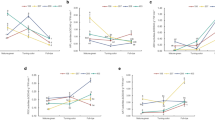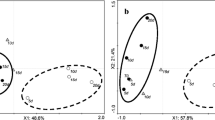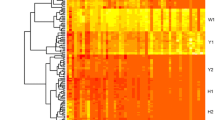Abstract
Volatile compounds are together with sugars and organic acids the main determinants of tomato fruit flavour and are therefore important for consumer acceptance. Consequently, in the last years many studies have been performed using different volatile analytical techniques on a large diversity of tomato fruits, aimed mainly at detecting the compounds affecting flavour or at the identification of QTLs and key genes involved in fruit volatile contents. The comparison of three of the analytical methods most commonly applied (headspace, solid phase microextraction, adsorption on Tenax followed by thermal desorption) revealed not only differences in sensitivity, but also dramatic variations in the volatile profile obtained by each of these techniques. The volatile profile was also largely influenced by the way samples were processed before analysis. Four widely used sample processing methods were compared (whole tomato, sliced fruit and two different types of fruit paste), each one producing a characteristic volatile pattern. Therefore, great care should be taken when comparing results available from the literature obtained by means of different methods, or when using the volatile levels obtained in an experiment to predict their influence on tomato flavor or consumer preference, or to assess the success of breeding programs.




Similar content being viewed by others
References
Allwood, J. W., Cheung, W., Xu, Y., et al. (2014). Metabolomics in melon: A new opportunity for aroma analysis. Phytochemistry, 99, 61–72.
Aubert, C., Baumann, S., & Arguel, H. (2005). Optimization of the analysis of flavor volatile compounds by liquid-liquid microextraction (LLME). Application to the aroma analysis of melons, peaches, grapes, strawberries, and tomatoes. Journal of Agricultural and Food Chemistry, 53, 8881–8895.
Baldwin, E. A., Goodner, K., & Plotto, A. (2008). Interaction of volatiles, sugars, and acids on perception of tomato aroma and flavor descriptors. Journal of Food Science, 73, S294–S307.
Baldwin, E. A., Goodner, K., Plotto, A., & Einstein, M. (2004). Effect of volatiles and their concentration on perception of tomato descriptors. Journal of Food Science, 69, S310–S318.
Baldwin, E. A., Nisperos-Carriedo, M. O., & Moshonas, M. G. (1991). Quantitative analysis of flavor and other volatiles and for certain constituents of 2 tomato cultivars during ripening. Journal of the American Society for Horticultural Science, 116, 265–269.
Baldwin, E. A., Scott, J. W., Einstein, M. A., et al. (1998). Relationship between sensory and instrumental analysis for tomato flavor. Journal of the American Society for Horticultural Science, 123, 906–915.
Beltran, J., Serrano, E., Lopez, F. J., Peruga, A., Valcarcel, M., & Rosello, S. (2006). Comparison of two quantitative GC-MS methods for analysis of tomato aroma based on purge-and-trap and on solid-phase microextraction. Analytical and Bioanalytical Chemistry, 385, 1255–1264.
Buttery, R. G. (1993). Quantitative and sensory aspects of flavor of tomato and other vegetables and fruits. In T. E. Acree & R. Teranishi (Eds.), Flavor science: Sensible principles and techniques (pp. 259–286). Washington: American Chemical Society.
Buttery, R. G., Teranishi, R., & Ling, L. C. (1987). Fresh tomato aroma volatiles: A quantitative study. Journal of Agricultural and Food Chemistry, 35, 540–544.
Buttery, R. G., Teranishi, R., Ling, L. C., Flath, R. A., & Stern, D. J. (1988). Quantitative studies on origins of fresh tomato aroma volatiles. Journal of Agricultural and Food Chemistry, 36, 1247–1250.
Cameron, A. C., & Yang, S. F. (1982). A simple method for the determination of resistance to gas diffusion in plant organs. Plant Physiology, 70, 21–23.
Carbonell-Barrachina, A. A., Agustí, A., & Ruiz, J. J. (2006). Analysis of flavor volatile compounds by dynamic headspace in traditional and hybrid cultivars of Spanish tomatoes. European Food Research and Technology, 222, 536–542.
Causse, M., Saliba-Colombani, V., Lecomte, L., Duffe, P., Rousselle, P., & Buret, M. (2002). QTL analysis of fruit quality in fresh market tomato: A few chromosome regions control the variation of sensory and instrumental traits. Journal of Experimental Botany, 53, 2089–2098.
Cebolla-Cornejo, J., Roselló, S., Valcárcel, M., Serrano, E., Beltrán, J., & Nuez, F. (2011). Evaluation of genotype and environment effects on taste and aroma flavor components of Spanish fresh tomato varieties. Journal of Agricultural and Food Chemistry, 59, 2440–2450.
Chen, G. P., Hackett, R., Walker, D., Taylor, A., Lin, Z., & Grierson, D. (2004). Identification of a specific isoform of tomato lipoxygenase (TomloxC) involved in the generation of fatty acid-derived flavor compounds. Plant Physiology, 136, 2641–2651.
Díaz de León-Sánchez, F., Pelayo-Zaldívar, C., Rivera-Cabrera, F., et al. (2009). Effect of refrigerated storage on aroma and alcohol dehydrogenase activity in tomato fruit. Postharvest Biology and Technology, 54, 93–100.
Farneti, B., Alarcon, A. A., Cristescu, S. M., et al. (2013). Aroma volatile release kinetics of tomato genotypes measured by PTR-MS following artificial chewing. Food Research International, 54, 1579–1588.
Gamero, A., Wesselink, W., & de Jong, C. (2013). Comparison of the sensitivity of different aroma extraction techniques in combination with gas chromatography-mass spectrometry to detect minor aroma compounds in wine. Journal of Chromatography A, 1272, 1–7.
Goff, S. A., & Klee, H. J. (2006). Plant volatile compounds: Sensory cues for health and nutritional value? Science, 311, 815–819.
Goulet, C., Mageroy, M. H., Lam, N. B., Floystad, A., Tieman, D. M., & Klee, H. J. (2012). Role of an esterase in flavour volatile variation within the tomato clade. Proceedings of the National Academy of Sciences, USA, 109, 19009–19014.
Granell, A., & Rambla, J. L. (2013). Biosynthesis of volatile compounds. In G. Seymour, G. A. Tucker, M. Poole, & J. J. Giovannoni (Eds.), The molecular biology and biochemistry of fruit ripening (pp. 135–161). Oxford, UK: Wiley-Blackwell. doi:10.1002/9781118593714.
Jaeger, S. R., McRae, J. F., Bava, C. M., et al. (2013). A Mendelian trait for olfactory sensitivity affects odor experience and food selection. Current Biology, 23, 1601–1605.
Mageroy, M. H., Tieman, D. M., Floystad, A., Taylor, M. G., & Klee, H. J. (2012). A Solanum lycopersicum catechol-O-methyltransferase involved in synthesis of the flavor molecule guaiacol. Plant Journal, 69, 1043–1051.
Mathieu, S., Dal Cin, V., Fei, Z., et al. (2009). Flavour compounds in tomato fruits: Identification of loci and potential pathways affecting volatile composition. Journal of Experimental Botany, 60, 325–337.
Matsui, K., Sugimoto, K., Mano, J., Ozawa, R. & Takabayashi, J. (2012). Differential metabolisms of green leaf volatiles in injured and intact parts of a wounded leaf meet distinct ecophysiological requirements. Plos One, 7, e36433. doi:10.1371/journal.pone.0036433.
Maul, F., Sargent, S. A., Balaban, M. O., Baldwin, E. A., Huber, D. J., & Sims, C. A. (1998). Aroma volatile profiles from ripe tomatoes are influenced by physiological maturity at harvest: An application for electronic nose technology. Journal of the American Society for Horticultural Science, 123, 1094–1101.
Maul, F., Sargent, S. A., Sims, C. A., Baldwin, E. A., Balaban, M. O., & Huber, D. J. (2000). Tomato flavor and aroma quality as affected by storage temperature. Journal of Food Science, 65, 1228–1237.
McDonald, R. E., McCollum, T. G., & Baldwin, E. A. (1996). Prestorage heat treatments influence free sterols and flavor volatiles stored at chilling temperature. Journal of the American Society for Horticultural Science, 121, 531–536.
McRae, J. F., Jaeger, S. R., Bava, C. M., et al. (2013). Identification of regions associated with variation in sensitivity to food-related odors in the human genome. Current Biology, 23, 1596–1600.
Niinemets, U., Kannaste, A. & Copolovici, L. (2013). Quantitative patterns between plant volatile emissions induced by biotic stresses and the degree of damage. Frontiers in Plant Science, 4, 262. doi:10.3389/fpls.2013.00262.
Nongonierma, A., Cayot, P., Le Quere, J. L., Springett, M., & Voilley, A. (2006). Mechanisms of extraction of aroma compounds from foods, using adsorbents. Effect of various parameters. Food Reviews International, 22, 51–94.
Ortiz-Serrano, P., & Gil, J. V. (2010). Quantitative comparison of free and bound volatiles of two commercial tomato cultivars (Solanum lycopersicum L.) during ripening. Journal of Agricultural and Food Chemistry, 58, 1106–1114.
Petró-Turza, M. (1987). Flavor of tomato and tomato products. Food Reviews International, 2, 309–351.
Rambla, J. L., Tikunov, Y. M., Monforte, A. J., Bovy, A. G., & Granell, A. (2014). The expanded tomato fruit volatile landscape. Journal of Experimental Botany, 65, 4613–4623.
Renard, C. M. G. C., Ginies, C., Gouble, B., Bureau, S., & Causse, M. (2013). Home conservation strategies for tomato (Solanum lycopersicum): Storage temperature vs. duration—is there a compromise for better aroma preservation? Food Chemistry, 139, 825–836.
Ruiz, J. J., Alonso, A., García-Martínez, S., Valero, M., Blasco, P., & Ruiz-Bevia, F. (2005). Quantitative analysis of flavour volatiles detects differences among closely related traditional cultivars of tomato. Journal of the Science of Food and Agriculture, 85, 54–60.
Schilmiller, A., Shi, F., Kim, J., et al. (2010). Mass spectrometry screening reveals widespread diversity in trichome specialized metabolites of tomato chromosomal substitution lines. Plant Journal, 62, 391–403.
Selli, S., Kelebek, H., Ayseli, M. T., & Tokbas, H. (2014). Characterization of the most aroma-active compounds in cherry tomato by application of the aroma extract dilution analysis. Food Chemistry, 165, 540–546.
Shen, J. Y., Tieman, D., Jones, J. B., et al. (2014). A 13-lipoxygenase, TomloxC, is essential for synthesis of C5 flavour volatiles in tomato. Journal of Experimental Botany, 65, 419–428.
Simkin, A. J., Schwartz, S. H., Auldridge, M., Taylor, M. G., & Klee, H. J. (2004). The tomato carotenoid cleavage dioxygenase 1 genes contribute to the formation of the flavor volatiles beta-ionone, pseudoionone, and geranylacetone. Plant Journal, 40, 882–892.
Tadmor, Y., Fridman, E., Gur, A., et al. (2002). Identification of malodorous, a wild species allele affecting tomato aroma that was selected against during domestication. Journal of Agricultural and Food Chemistry, 50, 2005–2009.
Tandon, K. S., Baldwin, E. A., Scott, J. W., & Shewfelt, R. L. (2003). Linking sensory descriptors to volatile and nonvolatile components of fresh tomato flavor. Journal of Food Science, 68, 2366–2371.
Tieman, D., Bliss, P., & McIntyre, L. M. (2012). The chemical interactions underlying tomato flavour preference. Current Biology, 22, 1035–1039.
Tieman, D. M., Loucas, H. M., Kim, J. Y., Clark, D. G., & Klee, H. J. (2007). Tomato phenylacetaldehyde reductases catalyze the last step in the synthesis of the aroma volatile 2-phenylethanol. Phytochemistry, 68, 2660–2669.
Tieman, D., Taylor, M., Schauer, N., Fernie, A. R., Hanson, A. D., & Klee, H. J. (2006a). Tomato aromatic amino acid decarboxylases participate in synthesis of the flavour volatiles 2-phenylethanol and 2-phenylacetaldehyde. Proceedings of the National Academy of Sciences, USA, 103, 8287–8292.
Tieman, D. M., Zeigler, M., Schmelz, E. A., et al. (2006b). Identification of loci affecting flavour volatile emissions in tomato fruits. Journal of Experimental Botany, 57, 887–896.
Tieman, D., Zeigler, M., Schmelz, E., et al. (2010). Functional analysis of a tomato salicylic acid methyl transferase and its role in synthesis of the flavor volatile methyl salicylate. Plant Journal, 62, 113–123.
Tikunov, Y. M., de Vos, R. C. H., Gonzalez-Paramas, A. M. G., Hall, R. D., & Bovy, A. G. (2010). A role for differential glycoconjugation in the emission of phenylpropanoid Volatiles from tomato fruit discovered using a metabolic data fusion approach. Physiology, 152, 55–70.
Tikunov, Y., Lommen, A., De Vos, C. H. R., et al. (2005). A novel approach for nontargeted data analysis for metabolomics. Large-scale profiling of tomato fruit volatiles. Plant Physiology, 139, 1125–1137.
Tikunov, Y. M., Molthoff, J., de Vos, R. C., et al. (2013). Non-smoky glycosyltransferase 1 prevents the release of smoky aroma from tomato fruit. Plant Cell, 25, 3067–3078.
Vogel, J. T., Tieman, D. M., Sims, C. A., Odabasi, A. Z., Clark, D. G., & Klee, H. J. (2010). Carotenoid content impacts flavour acceptability in tomato (Solanum lycopersicum). Journal of the Science of Food and Agriculture, 90, 2233–2240.
Zanor, M. I., Rambla, J. L., Chaib, J., et al. (2009). Metabolic characterization of loci affecting sensory attributes in tomato allows an assessment of the influence of the levels of primary metabolites and volatile organic contents. Journal of Experimental Botany, 60, 2139–2154.
Acknowledgments
We thank Rafael Fernández for providing excellent tomato fruits for this study. Funding to AG was provided through CALITOM and ESPSOL from FECYT and EUSOL (EU FP7 program) and Quality Fruit FA 1106.
Author information
Authors and Affiliations
Corresponding author
Ethics declarations
Conflict of interest
Jose Luis Rambla, Cristina Alfaro, Aurora Medina, Manuel Zarzo, Jaime Primo and Antonio Granell declared that they have no conflict of interest.
Human and Animal Rights and Informed Consent
This article does not contain any studies with human or animal subjects.
Electronic supplementary material
Below is the link to the electronic supplementary material.
11306_2015_824_MOESM1_ESM.pptx
Supplementary material 1 Table S1. Relative abundance of volatile compounds after different capturing methods. Footnote. Values represent the contribution of each individual compound related to the sum of the areas of all the peaks in the chromatogram, expressed as a percentage. RT, Retention Time (min); Kovats RI, Kovats Retention Index; m/z, specific ion used for compound quantitation; nd, not detected. (PPTX 103 kb)
11306_2015_824_MOESM2_ESM.pptx
Supplementary material 2 Figure S1. Representative Total Ion Chromatograms (TIC) obtained by each of the capturing methods used. Chromatograms are scaled to the highest peak (100 %). Numbers on the top right of each chromatogram indicate the absolute height (counts) as registered by the detector for the highest peak. In order to facilitate visual alignment of chromatograms, the peak corresponding to (Z)-3-hexenal + hexanal has been marked with an asterisk. (PPTX 80 kb)
11306_2015_824_MOESM3_ESM.xlsx
Supplementary material 3 Figure S2. Representative Total Ion Chromatograms (TIC) obtained by each of the sample processing methods used. Chromatograms are scaled to the highest peak (100 %). Numbers on the top right of each chromatogram indicate the absolute height (counts) as registered by the detector for the highest peak (XLSX 24 kb)
Rights and permissions
About this article
Cite this article
Rambla, J.L., Alfaro, C., Medina, A. et al. Tomato fruit volatile profiles are highly dependent on sample processing and capturing methods. Metabolomics 11, 1708–1720 (2015). https://doi.org/10.1007/s11306-015-0824-5
Received:
Accepted:
Published:
Issue Date:
DOI: https://doi.org/10.1007/s11306-015-0824-5




